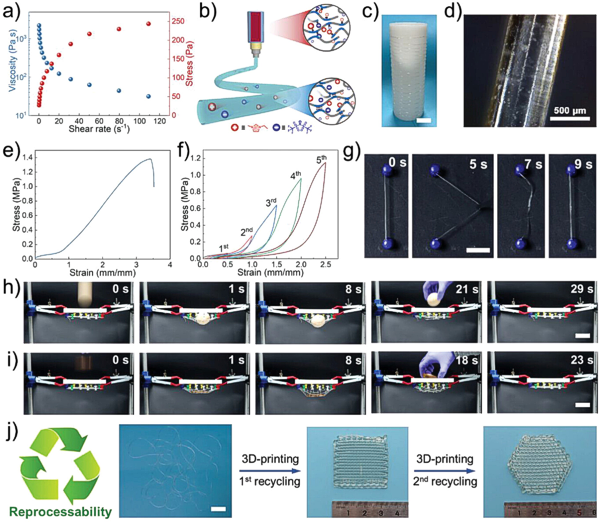Self-Healing Ionogels Modeled After Spider Silk:
Ionogels are three-dimensional polymer matrices infused with ionic liquids (ILs), offering unique properties such as high ionic conductivity, thermal and chemical stability, environmental resilience, and flexibility. Despite their advantages, ionogel-based devices are prone to damage and functional degradation over time, leading to reduced performance or failure.
To address these challenges, researchers have explored self-healing mechanisms inspired by living organisms. While self-healing ionogels based on reversible non-covalent interactions show promising repair abilities at room temperature, they often suffer from low mechanical strength. On the other hand, ionogels using dynamic covalent bonds exhibit higher robustness but usually require external stimuli like heat or light to enable self-healing, limiting their efficiency. Achieving a balance between high mechanical strength and efficient self-healing under ambient conditions remains a major hurdle.
Inspired by spider silk, known for its extraordinary mechanical properties, the study introduces a multilevel hydrogen bonding strategy to enhance mechanical strength and enable self-healing properties. Spider silk’s structure serves as a model for designing ionogels with exceptional strength and toughness. Poly(N-isopropylacrylamide) (PNIPAM) and poly(N,N-dimethylacrylamide) (PDMA) chains mimic these natural structures, enabling the ionogel to dissipate energy through hydrogen bonding interactions akin to spider silk.
The methods involve synthesizing ionogels using N-isopropylacrylamide (NIPAM), N,N-dimethylacrylamide (DMA), and ionic liquids (ILs) like 1-ethyl-3-methylimidazolium bis(trifluoromethylsulfonyl)imide ([EMI][TFSI]). The synthesized ionogels were printed utilizing a BioScaffolder 4.2. The ionogels were first loaded into an extrusion cartridge. After melting at 145 °C for 10 min, the homogeneous, low-viscosity, and transparent ionogels were extruded utilizing a 0.7 mm diameter flat tip needle at an extrusion speed of 6 mm s−1.
The results demonstrate that these ionogel fibers exhibit spider-silk-like features, including excellent energy dissipation and hysteresis behavior. They also possess strain and thermal sensing capabilities, allowing precise object location detection. Additionally, the ionogels show great recyclability and can be shaped into various forms using 3D printing.
The research further demonstrates that the developed ionogels exhibit superior self-healing performance, recyclability, and processability through techniques like 3D printing and spinning. By leveraging dynamic hydrogen bonding interactions, these ionogels provide innovative solutions to enhance durability, sustainability, and reduce electronic waste. This design principle opens a new avenue for the development of high-performance materials.
This article is based on the following publication:
Sun, L.; Huang, H.; Zhang, L.; Esmaeely Neisiany, R.; Ma, X.; Tan, H.; You, Z. Spider-Silk-Inspired Tough, Self-Healing, and Melt-Spinnable Ionogels. Advanced Science 2024, 11, 2305697.https://doi.org/10.1002/advs.202305697

